Welcome to the ultimate guide to Yellowstone National Park’s stargazing locations. Immerse yourself in the beauty of Yellowstone’s celestial wonders, where every clear night reveals a unique display of stars, planets, and other heavenly bodies. The park’s minimal light pollution and clear night skies make it a haven for Wyoming stargazing.
My guide is packed with comprehensive Astronomy in Yellowstone tips, offering practical advice from selecting the Best time for Yellowstone stargazing to picking those sweet spots for the most excellent views. If you’re fascinated by Night sky photography in Yellowstone, I’ve dedicated a whole section to hone your astrophotography skills. This guide will also shed light on the necessary astronomy equipment for Yellowstone stargazing, ensuring you come prepared.
Beyond your exploration, I’ll give you the ins and outs of joining guided stargazing tours in Yellowstone. Learn more about the park’s unique ecosystem, experience the thrill of wildlife and stargazing in Yellowstone, and relish the mesmerizing Yellowstone night sky experience.
Be it the raw solitude of the night in one of the many campgrounds for stargazing in Yellowstone or the magic of meteor showers in Yellowstone, this guide will not disappoint. You’ll find tips on attending astronomy events in Yellowstone and advice on capturing those perfect shots for your Tips for astrophotography in Yellowstone.
To enhance your experience, I also inform you about Yellowstone’s efforts towards attaining Dark Sky Certification, the Stargazing safety in Yellowstone, and the initiatives taken by the various Astronomy clubs in Yellowstone.
With this guide, you’re one step closer to witnessing the captivating harmony of stars and Wilderness. Embrace the hushed whispers of the night as you unravel what makes the Best stargazing spots in Yellowstone genuinely magical.
In this guide, you get to
Immerse: Immerse yourself in the beauty of Yellowstone’s celestial wonders.
Discover: Discover comprehensive Astronomy in Yellowstone tips.
Learn: Learn how to understand and navigate the night sky in Yellowstone country.
Explore: Explore prime stargazing spots in Yellowstone.
Understand: Understand the criteria for choosing the best stargazing locations.
Visit: Visit Dunraven Pass and experience your star-filled adventure.
Experience: Experience stargazing among geysers at Upper Geyser Basin.
Enjoy: Enjoy the serenity of stargazing in Lamar Valley.
Capture: Capture the beauty of the night sky with night photography tips.
Explore Further: Explore common FAQs and practical advice for Yellowstone stargazing.
By the end of this article, you’ll be well-equipped to embark on a mesmerizing stargazing adventure in Yellowstone National Park, armed with knowledge about the best spots, essential tips, and even night photography techniques to capture the beauty of the night sky.
Let’s dive right in.
Stargazing 101: Basics for the newbie astronomer

After a day of exploring the park, you might wonder how to enjoy the night sky in Yellowstone. In this section, I will give you some tips and advice on understanding and navigating the night sky, as well as what to bring and what to avoid for your stargazing adventure.
Understanding the sky: A beginner’s guide
The first step to stargazing is to understand the basics of the sky. Here are some of the key concepts and terms that you should know:
- The sky is divided into two hemispheres: the northern and southern. Your hemisphere determines which stars and constellations you can see and how they move.
- The sky has four cardinal directions: north, south, east, and west. The direction you are facing determines where the sun, the moon, and the planets rise and set, as well as how they move across the sky.
- The sky is divided into 24 sections called hours, each of which corresponds to 15 degrees of longitude on Earth. The hour you are currently in determines the time of day or night, as well as the position of the stars and constellations in the sky.
- The sky has 88 regions called constellations. Each constellation is a group of stars that form a recognizable pattern or shape in the sky. Some of the most famous constellations are Orion, Ursa Major, Cassiopeia, and Scorpius.
- The sky also has 12 sections called zodiac signs. Each zodiac sign is a constellation along the ecliptic, the path that the sun, the moon, and the planets follow in the sky. Some of the most famous zodiac signs are Aries, Taurus, Gemini, and Cancer.
- There are also two bands called the celestial equator and the celestial poles. The celestial equator is an imaginary line that divides the sky into two halves, corresponding to the equator on Earth. The celestial poles are two points in the sky directly above Earth’s north and south poles.
These are just some of the essential elements of the sky with which you should be familiar. You can learn more about them by reading books, watching videos, or using apps that explain and illustrate them.
Navigating the night sky: Locating constellations, planets, and the moon
The next step to stargazing is to navigate the night sky and locate constellations, planets, and the moon. Here are some of the methods and tools that you can use:
- A star map or a star chart is a diagram showing the stars’ position and appearance and constellations in the sky for a specific date, time, and location. You can use a star map or a star chart to identify and find different stars and constellations in the sky by matching them with what you see with your eyes.
- A star wheel or a planisphere is a device that consists of two rotating disks that show the stars and constellations in the sky for any date and time. You can use a star wheel or a planisphere to locate and track different stars and constellations in the sky by adjusting it according to your date, time, and location.
- A compass or a smartphone is a device that shows you the cardinal directions: north, south, east, and west. You can use a compass or a smartphone to orient yourself and find different stars and constellations in the sky by knowing which direction they rise and set.
- A telescope or binoculars is a device that magnifies distant objects in the sky, such as planets, moons, nebulae, and galaxies. You can use a telescope or binoculars to observe and explore different objects in the sky by pointing them at them and adjusting their focus and zoom.
These are just some of the methods and tools you can use to navigate the night sky.
Prime Stargazing Spotlights in Yellowstone

Now that you know how to understand and navigate the night sky, you might wonder where to go in Yellowstone to enjoy it.
In this section, I will give you some suggestions and recommendations on the best stargazing spots in Yellowstone and what to expect and watch out for in each location.
FREE STARGAZING CHECKLIST
My 5-page Stargazing Checklist will enhance your astronomical observations.
Follow this free checklist to navigate the night sky with confidence, clarity, and a sense of preparedness for a rewarding stargazing experience.

Great Spots for Yellowstone Stargazing: An Overview
Yellowstone has many great spots for stargazing, but some are better than others depending on the season, the weather, the accessibility, and the light pollution.
Here are some of the general criteria that you should consider when choosing a stargazing spot in Yellowstone:
- Elevation: Higher elevation means thinner air and clearer sky, which allows more light to reach your eyes. However, higher elevation also means colder temperatures and stronger wind, making you uncomfortable and affecting your equipment.
- Openness: More openness means a broader view and less obstruction, which allows you to see more stars and constellations. However, more openness also means less shelter and more exposure, making you vulnerable to wildlife and weather.
- Darkness: Less light pollution means a darker sky and brighter stars, which allows you to see more details and colors. However, less light pollution also means less visibility and safety, making you feel lost and scared.
- Distance: Closer distance means easier access and convenience, which allows you to save time and energy. However, closer distance also means more crowds and noise, making you annoyed and distracted.
Based on these criteria, here are some of the best stargazing spots in Yellowstone that I recommend:
Dunraven Pass: Your star-filled adventure awaits
Dunraven Pass is a mountain pass that connects Tower Junction and Canyon Village. It is one of the highest points in the park, reaching an elevation of 8,859 feet. It is also one of the darkest spots in the park, as it is far away from any major light sources. It offers a spectacular view of the night sky and the surrounding mountains and forests.
Some of the advantages of Dunraven Pass are:
- It has a large parking lot that can accommodate many cars and RVs.
- It has a backcountry campsite (4D1) that can be reserved for overnight stays.
- It has a trailhead that leads to Mount Washburn Peak, another excellent stargazing spot.
Some of the disadvantages of Dunraven Pass are:
- It is closed from early October to late May due to snow and ice.
- It is often windy and chilly at night, especially during winter.
- It is frequented by bears and other wildlife, especially during dawn and dusk.
If you choose Dunraven Pass as your stargazing spot, bring warm clothes, a flashlight, a bear spray, and a telescope or binoculars. You should also check the road conditions and closures before your trip.
Upper Geyser Basin: Stargazing among the geysers
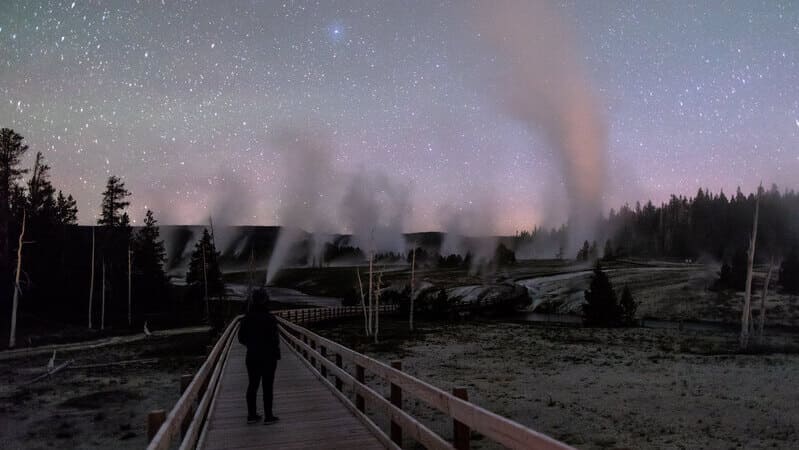
Upper Geyser Basin is a geothermal area with the largest concentration of geysers in the world, including Old Faithful. It is one of the most popular and accessible spots in the park, attracting millions of visitors every year. It offers a unique experience of stargazing among the geysers and the nearby Firehole River and Old Faithful Inn.
Some of the advantages of the Upper Geyser Basin are:
- It is open year-round, except for temporary closures due to maintenance or weather.
- The visitor center provides information and education about the geysers and the night sky.
- It has a campground (8G1) that can be reserved for overnight stays.
Some of the disadvantages of the Upper Geyser Basin are:
- It is very crowded and noisy during peak hours and seasons.
- It has moderate light pollution from nearby buildings and vehicles.
- It has steam, smoke, and heat from the geysers that can affect the atmosphere and create optical phenomena.
If you choose Upper Geyser Basin as your stargazing spot, you should bring a jacket, a hat, a water bottle, a star map, or a star wheel. You should also avoid walking on the boardwalks or near the geysers at night, as they can be dangerous and unpredictable.
Mammoth Hot Springs: Skyward views from the terraces
Mammoth Hot Springs is a complex of terraces, pools, and travertine formations that constantly change and grow due to the hot water and minerals that flow from below. It is one of the park’s most scenic and historic spots, featuring the Mammoth Hot Springs Hotel, the Fort Yellowstone, and the Albright Visitor Center. It offers a stunning view of the night sky, terraces, and nearby mountains.
Some of the advantages of Mammoth Hot Springs are:
- It is open year-round, except for temporary closures due to maintenance or weather.
- It has a hotel that provides lodging, dining, and entertainment.
- The visitor center offers information and education about the hot springs and the night sky.
Some of the disadvantages of Mammoth Hot Springs are:
- It is bustling and noisy during peak hours and seasons.
- It has moderate light pollution from nearby buildings and vehicles.
- It has steam, smoke, and heat from the hot springs that can affect the atmosphere and create optical phenomena.
If you choose Mammoth Hot Springs as your stargazing spot, you should bring a jacket, a hat, a water bottle, a star map, or a star wheel. You should also avoid walking on the boardwalks or near the hot springs at night, as they can be slippery and unstable.
Mount Washburn Peak: A stargazer’s pinnacle
Mount Washburn Peak is a mountain peak that rises 10,243 feet above sea level. It is one of the highest and most prominent points in the park, offering a panoramic view of the park and beyond. It is also one of the most challenging and rewarding spots in the park, requiring a strenuous hike or bike ride to reach it.
Some of the advantages of Mount Washburn Peak are:
- It has a fire lookout tower as an observation deck and a shelter.
- It has a backcountry campsite (4Y1) that can be reserved for overnight stays.
- It has a trailhead that leads to Dunraven Pass, another fantastic stargazing spot.
Some of the disadvantages of Mount Washburn Peak are:
- It is closed from early October to late May due to snow and ice.
- It is often windy and cold at night, especially during winter.
- It is frequented by bears and other wildlife, especially during dawn and dusk.
If you choose Mount Washburn Peak as your stargazing spot, bring warm clothes, a flashlight, a bear spray, and a telescope or binoculars. You should also check the trail conditions and closures before your trip.
Lamar Valley: Night Sky in the Wilderness
Lamar Valley is a wide valley that stretches for 29 miles along the Lamar River. It is one of the best places to see wildlife in the park, especially at dawn and dusk. It is also one of the park’s most remote and wild spots, offering a serene and peaceful experience of stargazing in the Wilderness.
Some of the advantages of Lamar Valley are:
- The area has multiple pullouts and picnic spots that are suitable for stargazing.
- You can reserve several backcountry campsites (3L1-3L6) for overnight stays.
- Several trailheads lead to other stargazing locations, such as Mount Washburn Peak and Slough Creek Campground.
Some of the disadvantages of Lamar Valley are:
- It is very dark and isolated at night, making you feel scared and lost.
- It is frigid and windy at night, especially during winter.
- It is significantly populated by bears and other wildlife, making you vulnerable and endangered.
If you plan to stargaze at Lamar Valley, bring warm clothes, a flashlight, bear spray, and a telescope or binoculars. Stay alert, be aware of your surroundings, and follow park rules.
Swan Lake Flat: Stargazing by the tranquil waters
Swan Lake Flat is a large meadow that surrounds Swan Lake, a small lake that is home to swans, ducks, geese, and other waterfowl. It is one of the most tranquil and relaxing spots in the park, offering a soothing experience of stargazing by the calm waters. It provides a clear and unobstructed view of the night sky, as well as the reflection of the stars on the lake.
Some of the advantages of Swan Lake Flat are:
- It is open year-round, except for some temporary closures due to maintenance or weather.
- It has a picnic area that can be used for stargazing.
- It has a campground (1N1) that can be reserved for overnight stays.
Some of the disadvantages of Swan Lake Flat are:
- It is very cold and humid at night, especially during winter.
- It is very dark and quiet at night, which can make you feel lonely and bored.
- It is significantly populated by mosquitoes and other insects, which can make you itchy and irritated.
If you choose Swan Lake Flat as your stargazing spot, you should bring warm clothes, a flashlight, a bug spray, and a telescope or binoculars. You should also bring some snacks and drinks to enjoy by the lake.
Organized Stargazing Activities
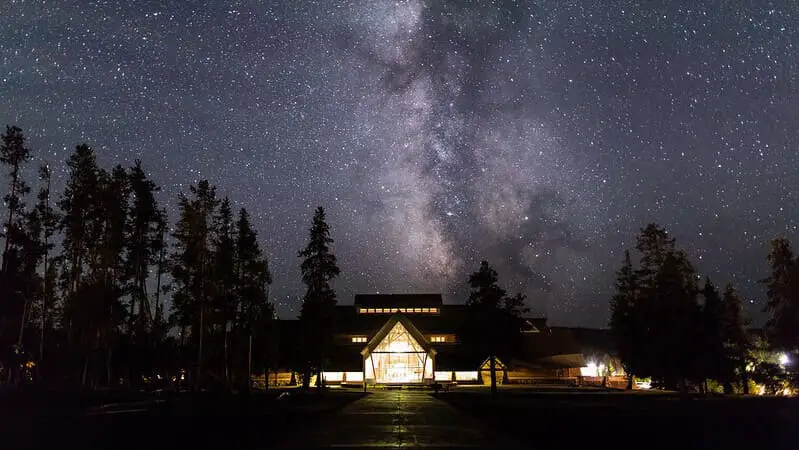
If you prefer to join organized stargazing activities instead of doing it on your own, you have some options in Yellowstone.
In this section, I will give you some information and suggestions on the best-organized stargazing activities in Yellowstone, as well as what to expect and what to prepare for each activity.
Madison Amphitheater Astronomy Program
The Madison Amphitheater Astronomy Program is a free program that is offered by the park rangers at the Madison Campground Amphitheater. It is held every Friday and Saturday night from mid-June to mid-September, starting at 9:30 p.m. or 10 p.m., depending on the sunset time. It lasts for about an hour and consists of a presentation, a Q&A session, and a telescope viewing.
Some of the advantages of the Madison Amphitheater Astronomy Program are:
- It is educational and entertaining, as you can learn about the stars, the planets, the moon, and other celestial objects from the park rangers.
- It is interactive and engaging, as you can ask questions, share your opinions, and participate in activities.
- It is convenient and accessible, as you can easily walk or drive to the amphitheater from your lodging or camping site.
Some of the disadvantages of the Madison Amphitheater Astronomy Program are:
- It is weather-dependent and subject to cancellation, as it can be affected by clouds, rain, or wind.
- It is crowded and noisy, as it can attract hundreds of people every night.
- It is limited and restricted, as it only covers specific topics and objects in the sky.
If you choose to join the Madison Amphitheater Astronomy Program, you should bring a jacket, a hat, a water bottle, and a star map or a star wheel. It would help if you also arrived early to get a good seat and follow the park rules and etiquette.
Guided night tours in Yellowstone
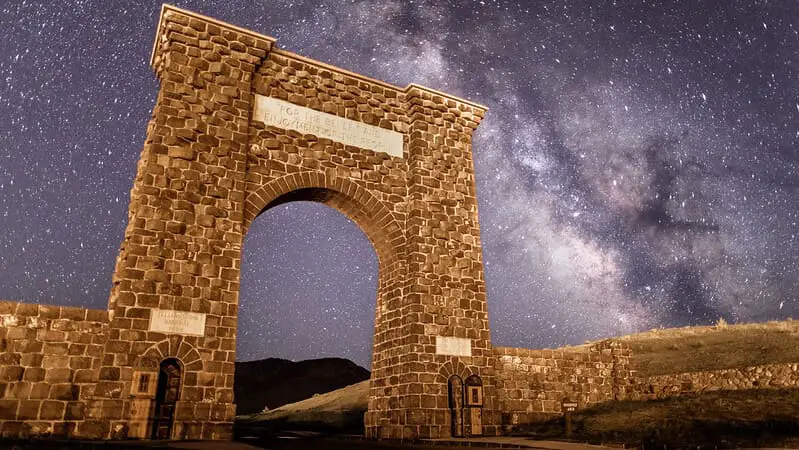
Guided night tours in Yellowstone are paid tours that are offered by various companies and organizations that operate in or near the park. They are held on selected nights throughout the year, starting at different times depending on the season and the tour. They last for several hours and consist of transportation, a narration, and a stargazing session.
Some of the advantages of guided night tours in Yellowstone are:
- They are professional and reliable, as you can rely on the expertise and experience of the guides.
- They are comfortable and convenient, as you can enjoy the transportation and equipment provided by the tour operators.
- They are exclusive and personalized, as you can choose from different types of tours that suit your preferences and needs.
Some of the disadvantages of guided night tours in Yellowstone are:
- They are expensive and competitive, as you have to pay for the tour fees and book your tour in advance.
- They are dependent and restricted, as you have to follow the tour schedule and itinerary.
- They are variable and unpredictable, as they can be affected by traffic, weather, wildlife, or other factors.
If you choose to join a guided night tour in Yellowstone, you should bring warm clothes, a flashlight, a camera, and some snacks and drinks. You should also check the tour details and reviews before your trip and follow the tour instructions and regulations.
Night Photography Tips
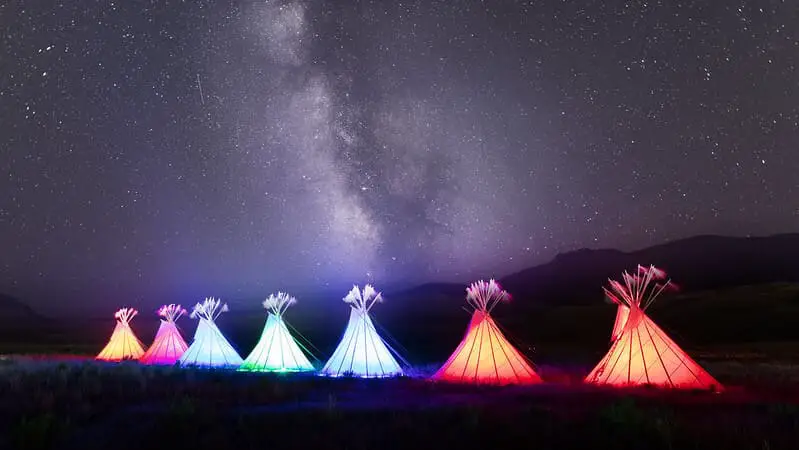
If you want to capture the beauty of the night sky in Yellowstone with your camera, you need to know some tips and techniques for night photography.
In this section, I will give you some advice and suggestions on how to take night photos in Yellowstone, as well as what to bring and what to avoid for your night photography adventure.
Understanding Nighttime Photography: Basics and Techniques
The first step to night photography is to understand its basics and techniques.
Here are some of the key concepts and terms that you should know:
- Exposure: Exposure is the amount of light that reaches your camera sensor. It is determined by three factors: aperture, shutter speed, and ISO. Aperture is the size of the opening that lets light in; shutter speed is the length of time that the shutter stays open; and ISO is the sensitivity of the sensor to light. To get a good exposure at night, you need to use a large aperture (small f-number), a long shutter speed (slow), and a high ISO (800 or above).
- Focus: Focus is the sharpness and clarity of your image. It is determined by two factors: distance and depth of field. Distance is the distance between your camera and your subject; depth of field is the range of distance that appears sharp in your image. To get a good focus at night, you need to use a manual focus mode, a tripod, and a remote shutter release or a self-timer.
- Composition: Composition is the arrangement and balance of your image. It is determined by two factors: framing and rule of thirds. Framing is the way you position your subject and background in your image; the rule of thirds is the way you divide your image into nine equal parts with two horizontal and two vertical lines. To get a good composition at night, you need to use a wide-angle lens, a level horizon, and a foreground interest.
These are just some of the necessary elements of nighttime photography with which you should be familiar. You can learn more about them by reading books, watching videos, or taking courses that teach and demonstrate them.
How to Take Night photos in Yellowstone: A step-by-step guide
The next step in night photography is to take night photos in Yellowstone.
Here are some of the steps and tips that you can follow:
- Choose your location: As mentioned before, Yellowstone has many great spots for stargazing and night photography. You should choose a location that has a clear and unobstructed view of the sky, as well as a dark and quiet environment. You should also select a location that has safe and easy access, as well as a nearby lodging or camping site.
- Choose your time: As mentioned before, the best time to visit Yellowstone for stargazing depends on what you want to see in the sky and what kind of weather you prefer. Check the weather forecast and the sky chart before your trip to find out the best time for your night photography session. You should also check the moon’s phase and avoid nights when the moon is full or bright, as it can wash out the stars.
- Choose your equipment: As mentioned before, you need some equipment for night photography, such as a camera, a lens, a tripod, a remote shutter release or a self-timer, a flashlight, and extra batteries. It would be best if you chose a camera that has a manual mode, a RAW format, and a noise reduction feature; a lens that has a wide-angle focal length, a large aperture, and an infinity focus mark; and a tripod that has a sturdy base, an adjustable height, and a ball head.
- Set up your camera: Once you have chosen your location, time, and equipment, you need to set up your camera for night photography. You should mount your camera on your tripod, turn on your camera, and switch to manual mode. You should set your aperture to the largest value (smallest f-number), your shutter speed to 15 seconds or longer, and your ISO to 800 or higher. You should also set your white balance to daylight or auto, your metering mode to spot or center-weighted, and your focus mode to manual. You should then point your camera at your subject, use your flashlight to illuminate it, and adjust your focus ring until it is sharp. You should also use your remote shutter release or your self-timer to avoid camera shake.
- Take your photo: After you have set up your camera, you are ready to take your photo. You should press the shutter button, wait for the exposure to finish, and check the result on your LCD screen. You should then review your photo and make any adjustments if needed. You can adjust your exposure, focus, composition, or other settings until you are satisfied with your photo. You can also take multiple photos of the same or different subjects and compare them later.
Common FAQs About Stargazing in Yellowstone
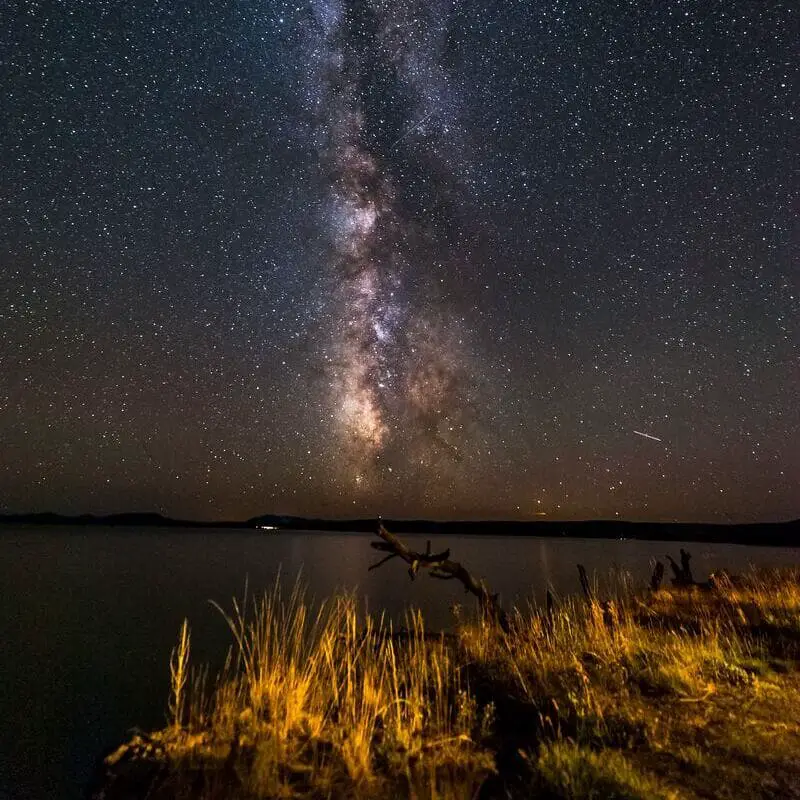
In this section, I will answer some of the most common questions that people have about stargazing in Yellowstone.
Can you see the Milky Way while stargazing in Yellowstone?
Yes, you can see the Milky Way while stargazing in Yellowstone, as long as the sky is clear and dark enough. The Milky Way is the galaxy that contains our solar system and billions of other stars. It appears as a faint band of light that stretches across the sky from horizon to horizon. The best time to see the Milky Way in Yellowstone is between April and October when it is visible over the park. The best time of night is around midnight or later when it is highest in the sky.
Is there a dark sky festival in Yellowstone?
No, there is no dark sky festival in Yellowstone, but there are other events and programs that celebrate and promote the night sky in the park. For example, there is the Madison Amphitheater Astronomy Program, which is a free program that is offered by the park rangers every Friday and Saturday night from mid-June to mid-September. There are also guided night tours in Yellowstone, which are paid tours that are offered by various companies and organizations that operate in or near the park.
Is Yellowstone National Park open at night?
Yes, Yellowstone National Park is open at night, but some areas and facilities may be closed or restricted due to safety or conservation reasons. For example, some roads, trails, boardwalks, and geysers may be closed or restricted at night due to snow, ice, wildlife, or geothermal activity. Some hotels, cabins, campgrounds, and visitor centers may also be closed or have limited hours at night due to maintenance or seasonality. You should always check the current conditions and closures before your trip.
Can you see the northern lights in Yellowstone?
Yes, you can see the northern lights in Yellowstone, but it is sporadic and unpredictable. The northern lights, also known as aurora borealis, are natural displays of colorful lights that occur in the upper atmosphere due to the interaction of charged particles from the sun and the Earth’s magnetic field. The best time to see the northern lights in Yellowstone is during the winter months when the nights are longer and darker. The best time of night is unpredictable, but usually between 10 p.m. and 2 a.m. The best place to see the northern lights in Yellowstone is anywhere that has a clear and unobstructed view of the northern horizon.
Summary: Best Stargazing in Yellowstone
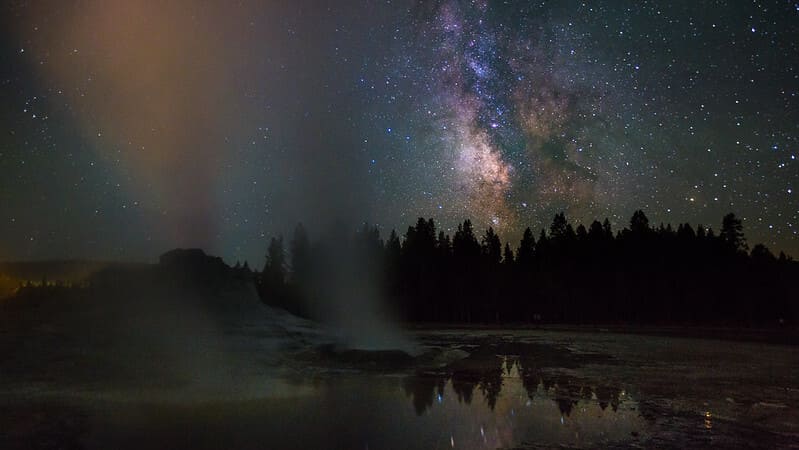
Thank you for reading my article about Yellowstone stargazing.
In this article, I have shared with you everything you need to know about stargazing in Yellowstone National Park, one of the most amazing places on Earth, to witness the wonders of the night sky.
Making the most of your stargazing adventure
To make the most of your stargazing adventure in Yellowstone, you should follow these tips:
- Plan ahead: Do your research and preparation before your trip to find out the best spots, times, clear sky, and equipment for stargazing in Yellowstone.
- Be flexible: Be ready to adapt and improvise according to the weather, wildlife, traffic, or other factors that may affect your stargazing experience in North America.
- Be respectful: Be mindful of your impact on the environment and other people while stargazing in Yellowstone. Follow the park rules and etiquette, leave no trace, and minimize your noise and light pollution.
- Be curious: Be open to learning and discovering new things while stargazing in Yellowstone. Ask questions, share your opinions, and participate in activities.
- Be grateful: Be thankful for the opportunity and privilege to stargaze in Yellowstone. Appreciate the beauty and mystery of the night sky and nature.
I hope you enjoyed this article and found it helpful. If you have any feedback or suggestions for me, please let me know. I am always eager to improve and learn from you.
Happy Stargazing!
Additional articles from my Dark Sky Parks series you may enjoy:
- Acadia National Park
- Anza-Borrego Desert State Park
- Arches National Park
- Big Bend National Park
- Bryce Canyon National Park
- Capulin Volcano Dark Sky Park
- Cherry Springs State Park
- Copper Breaks State Park
- Cosmic Campground Dark Sky Sanctuary
- Death Valley National Park
- Enchanted Rock State Natural Area
- Grand Canyon National Park
- Great Basin National Park
- Haleakala National Park
- Joshua Tree National Park
- Massacre Rim Dark Sky Sanctuary
- Olympic National Park
- Oracle State Park
- Red Rock Canyon State Park
- Rocky Mountain National Park
- Tonopah Stargazing Park
- Zion National Park




